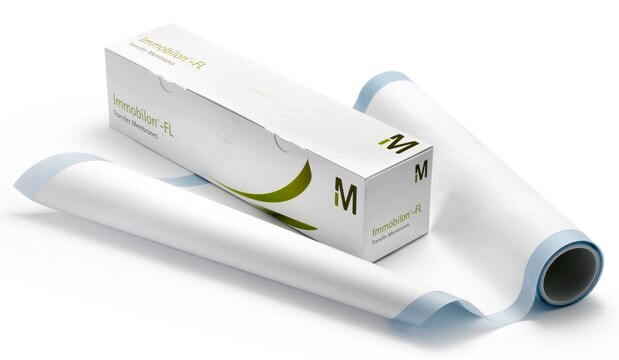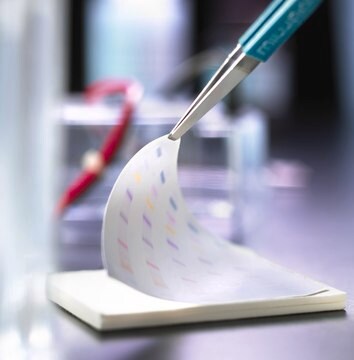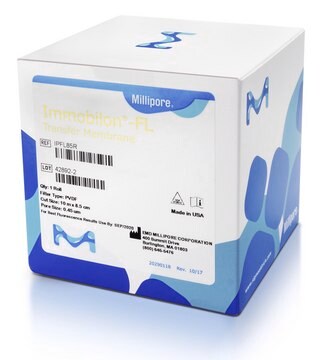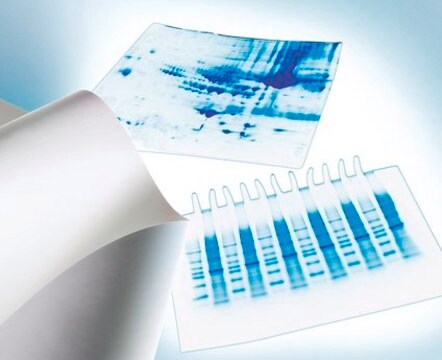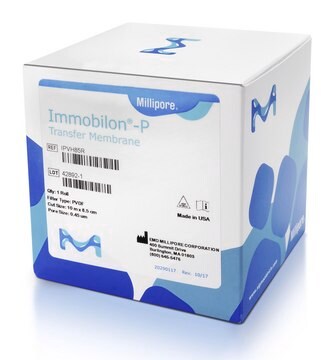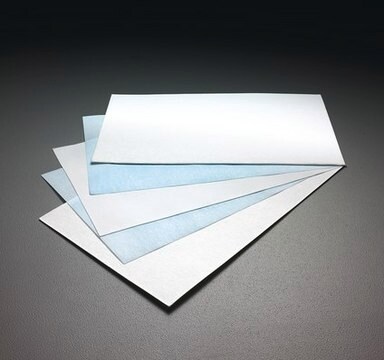IPFL10100
Immobilon® -FL PVDF Membrane
10 sheets, 10 cm x 10 cm, 0.45 µm pore size, transfer membrane with low background fluorescence
Sinónimos:
Western blotting membrane, blotting membrane, transfer membrane
About This Item
Productos recomendados
Nombre del producto
Immobilon®-FL PVDF Membrane, 10 sheets, 10 cm x 10 cm, 0.45 µm pore size, Hydrophobic PVDF Transfer Membrane with low background fluorescence for Western blotting. Compatible with visible and infrared fluorescent probes.
Materiales
PVDF membrane
plain filter
white filter
Nivel de calidad
Características
hydrophobic
fabricante / nombre comercial
Immobilon®
técnicas
dot blot: suitable
western blot: suitable
filtro L × An
10 cm × 10 cm
tamaño de poro
0.45 μm pore size
capacidad
155 μg/cm2 adsorption capacity (insulin)
205 μg/cm2 adsorption capacity (BSA)
300 μg/cm2 adsorption capacity (goat IgG)
compatibilidad
for use with Amido black
for use with CPTS
for use with Coomassie brilliant blue
for use with Ponceau-S red
método de detección
chemiluminescent
colorimetric
fluorometric
Condiciones de envío
ambient
Descripción general
Aplicación
Características y beneficios
- The first transfer membrane designed for fluorescence applications Extremely low background improves the sensitivity of all fluorescence detection protocols
- Compatible with all commonly used fluorescent probes at all excitation and emission wavelengths
- compatible with standard blocking agents and buffers
- Ideal for multiplexing and chemifluorescence detections
Información legal
Código de clase de almacenamiento
11 - Combustible Solids
Clase de riesgo para el agua (WGK)
WGK 3
Punto de inflamabilidad (°F)
Not applicable
Punto de inflamabilidad (°C)
Not applicable
Certificados de análisis (COA)
Busque Certificados de análisis (COA) introduciendo el número de lote del producto. Los números de lote se encuentran en la etiqueta del producto después de las palabras «Lot» o «Batch»
¿Ya tiene este producto?
Encuentre la documentación para los productos que ha comprado recientemente en la Biblioteca de documentos.
Los clientes también vieron
Nuestro equipo de científicos tiene experiencia en todas las áreas de investigación: Ciencias de la vida, Ciencia de los materiales, Síntesis química, Cromatografía, Analítica y muchas otras.
Póngase en contacto con el Servicio técnico